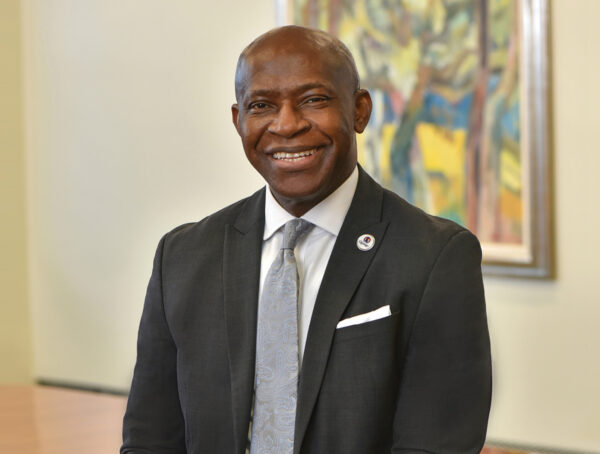SUNY Oswego Makes Great Strides in Sustainability
Since the First Earth Day Celebration 50 Years Ago
Fifty years ago on April 22, art major Ken Froebig ’72 and childhood education major Greg Loan ’72 helped lead SUNY Oswego’s participation in the country’s first Earth Day celebration. Joining other college students across the country in protest of “gas-guzzling” automobiles, they decided to bury a 1960 Chrysler DeSoto in front of Culkin Hall after filling the donated car with litter collected from around Oswego. (Listen to a Podcast of their reflections of this event.)
Burying the car was only one of many events during the first weeklong celebration that raised awareness of environmental issues. During the first Earth Week in 1970, stories in the Oswegonian reported that Oswego students presented a “fast-paced stage play” that combined environmental readings with dramatic lighting, staging and sound effects. Students decorated Poucher Hall with displays about pollution and the need to clean up the water and air, including artwork depicting the Statue of Liberty wearing a gas mask.
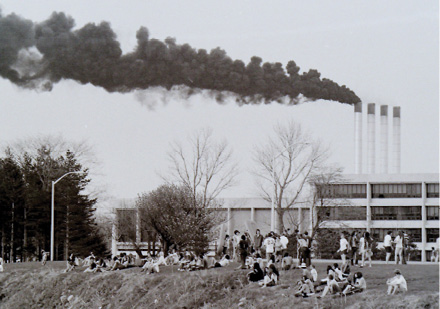
Photo by Jim Gemza ’70
The students attended numerous panels with elected officials, scientists and scholars; hosted a city-wide neighborhood clean-up and organized an environmental conference for area high school students. “Hot topics” of the day included thermal pollution, oil pollution, pesticides and over-population.
“We were young and idealistic, and we felt like the environment was being overlooked because of the war in Vietnam,” Ken said. “We were just starting to learn about things like pesticides from books like Silent Spring by Rachel Carson. Burying the car was an act of symbolism and consciousness. Looking back now, we know that it was perhaps one of the worst things we could do—putting those toxins in the ground.”
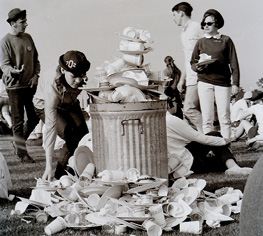
Photo by Jim Gemza ’70
These nascent acts of environmentalism planted a seed of consciousness in people like Ken—who as a college student also canoed with Greg on a Crusade for Cleaner Water from Oswego back home to New York City to encourage people to limit their gasoline consumption. Today, Ken runs the Tipi Village Retreat in the Mohawk Valley in Oregon, and maintains his passion for environmental activism. Greg went on to work for the Oswego County Conservation Corps and just retired from Utica National Insurance Company, where he worked in worker protection and property safety.
While, in retrospect, some of the college students’ actions—not just on the Oswego campus, but across the country—may now appear ill-advised, their intentions to raise awareness about pollution and environmental conservation helped to establish the topics as part of the national dialogue.
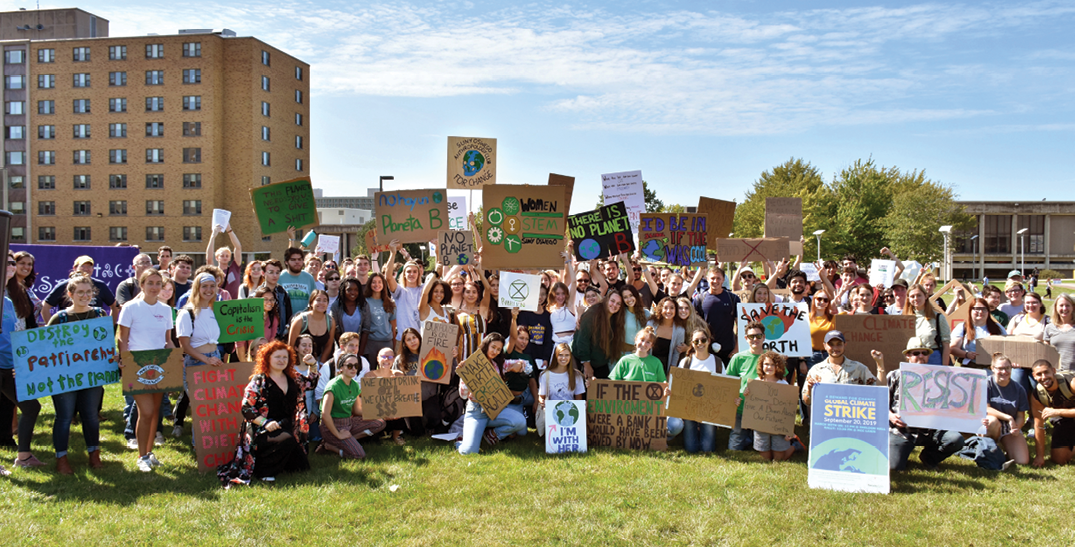
Members of the SUNY Oswego college community gathered Sept. 20, 2019, for a Climate Strike rally.
Oswego’s Green Legacy Carries On
Flash ahead nearly 50 years. It’s a sunny Friday in September 2019 on the SUNY Oswego campus. Students have gathered for a “Climate Strike” rally, coordinated worldwide by 16-year-old Swedish activist Greta Thunberg to raise awareness of climate change ahead of the Sept. 23 United Nations Climate Action Summit.
The Oswego students and protesters carried cardboard signs with such messages as “THE OCEANS R Rising & SO ARE WE,” “There is no Plan(et) B,” “Our house is on fire,” and “Skip a straw, save a turtle.” They chanted, “No more corporate greed. Renewable energy is what we need.”
Anthropology major and rally co-organizer Chelsie M. Scott ’20 was thrilled with the turnout at the rally, and the participants’ energy fueled her remarks.
“SUNY Oswego, it is time we make our voices heard and demand immediate action against climate change,” Chelsie said. “For too long we have sat idly by waiting for legislation to realize the immediate impact climate change is having on our people, our wildlife, our earth. We will no longer talk about the change we wish to see. We will take to the streets, with our fists held high, screaming at the top of our lungs, demanding change.”
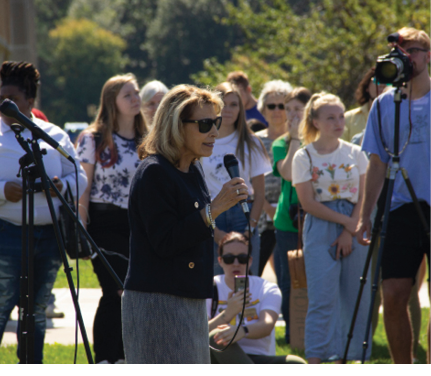
College President Deborah F. Stanley addressed the crowd who had gathered for the Climate Strike rally in September.
College President Deborah F. Stanley stood among the students, employees and community members who had gathered for the rally, and she took in the scene.
“I am here to listen, to absorb, but I am really here to get in my gut your energy, your understanding, your perspective,” Stanley told those gathered. “You inherit this world. It is yours from this day forward. It belongs to you—your generation and the generations that come after you. We need you.
“You must become the action generation,” she continued. “You must become the generation that doesn’t leave it on the Quad when the event is over. Take it home. Talk to parents and neighbors. Take it to your residence halls. Talk to your roommate. Everyone has a stake in this fight.”
Stanley shared with the students that in 2007 she signed the American College and University Presidents’ Climate Commitment, pledging to lower Oswego’s emissions and become carbon neutral by 2050.
“We need your conscience, as well … to help point out ways that we were not being vigilant and we were not taking things into account,” President Stanley said. “We needed to change, and we changed. And we will continue to change as time goes on.”
Since the 2007 Climate Commitment pledge, the college has instituted many changes and developed environmental standards that have guided institutional decision-making.
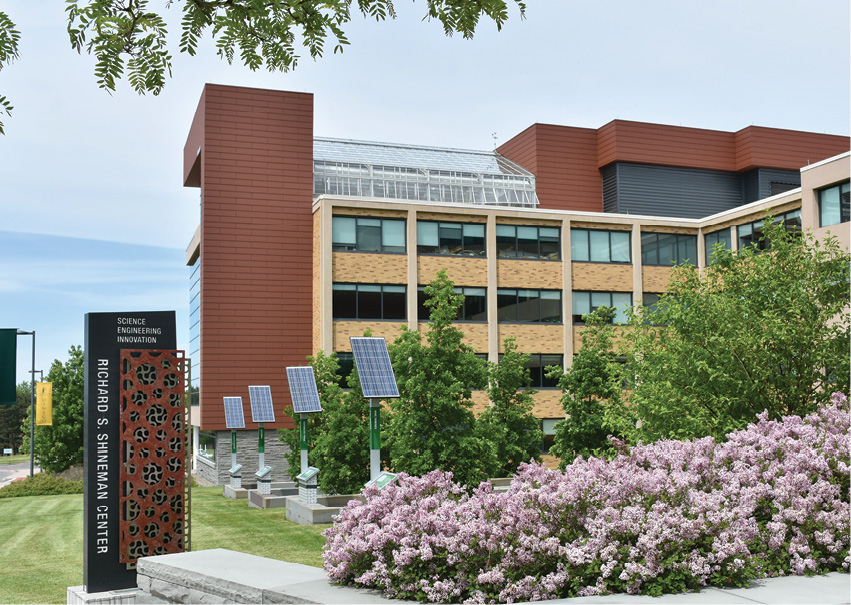
Shineman Center for Science, Engineering and Innovation earned Gold LEED Certification for its sustainable design and energy-efficient HVAC systems.
Nationally Recognized for Green Initiatives
For more than a decade, SUNY Oswego has shown great initiative in being a careful steward of its natural and fiscal resources. The college committed to putting its physical resources, capital assets and technological capabilities to their highest utility.
In 2009, the college created its first Climate Action Plan, which set a new direction for the college and outlined five steps for the college to pursue to reduce its carbon footprint. Oswego updated the plan in 2012 after creating an Environmental Sustainability Roadmap in 2011 and conducting a Transportation Survey in 2010.
The current plan set out to ensure that all our students are fully prepared for the future with the intellectual capacity, skills and access to technologies that enable them to innovate and adapt in an equitable, ethical and sustainable way.
“We envision a future where intentional learners with clear understanding of the interdependencies of social, economic and environmental challenges invent a better world and are prepared to address the root causes of societal issues,” President Stanley said.
Since 2007, all new construction on campus has met or exceeded the U.S. Green Building Council’s LEED Gold standard—an effort to partner with a national association to advance sustainable living. The certification signifies that the college
considered energy, carbon and waste reduction when making decisions during the design, construction and operation of the projects, according to Mitch Fields, associate vice president for facilities services.
In 2011, the college achieved the LEED Gold rating on its 68-unit townhouse student housing complex, The Village.
With the opening of the Shineman Center for Science, Engineering and Innovation in 2013, the college replaced the old “energy hog” Snygg Hall with the energy efficient Shineman Center, home to the state’s largest geothermal well that provides green energy to the 230,000-square-foot academic building.
Other recent construction projects—the School of Education’s Wilber Hall, the School of Communication, Media and the Arts’ Tyler Hall and Hewitt Hall, and Scales and Waterbury residence halls—also meet the LEED Gold certification.
 | 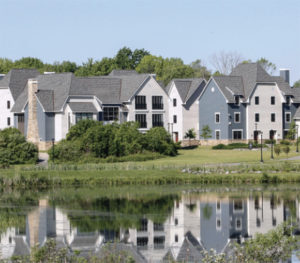 | 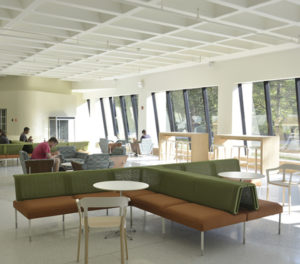 |
|---|---|---|
| Scales Hall— LEED Gold Certified | The Village—LEED Gold Certified | Tyler Hall—LEED Gold Certified |
With the demolition of Snygg Hall in 2014, SUNY Oswego has been “rightsized,” meaning that it has full utilization of all college buildings and can preserve the green space on campus.
“Once a building is constructed, it needs to be heated and maintained even if the spaces aren’t in use,” Mitch said. “Or think of it this way: If your vehicle couldn’t be turned off and would be using fuel 24/7, would you want to be driving a tractor trailer or a more fuel efficient small sedan? And wouldn’t you want to get the most use out of that running vehicle—maybe share it with others so that the running vehicle was in use as much as possible? That’s what we mean about right-sizing. We want enough classrooms to meet our needs, but not have a lot of spaces that aren’t being used for large portions of time.”
In 2018, the college announced “Clean Water for All,” its first-ever, campus-wide Grand Challenges project. Spanning two years, the project pulls together students, faculty, alumni and community members to work on multidisciplinary research, creative activities and service initiatives that are designed to advance the common good and contribute at the highest levels of theory and application to find solutions to the major societal challenge of ensuring clean water for all.
Also in 2018, Facilities Services and Campus Technology Services completed a data center renovation that reduced the size of the facility and modernized the power and cooling systems to drastically reduce power needs. More than 90 percent of the campus servers were virtualized, reducing power needs and simplifying the management of the systems.
The college is currently creating a comprehensive Clean Energy Roadmap with the help of New York State Energy Research and Development Authority and engineering firm O’Brien and Gere. SUNY Oswego is part of the N.Y. Higher Education Large-Scale Renewable Energy consortium, made up of 16 SUNY campuses and four private colleges that are using their collective purchasing power to develop new renewable projects by contracting renewable energy at scale. The goal is to expand this group to include all 64 SUNY campuses and become carbon neutral by 2040.
SUNY campuses have already reduced their carbon footprint from 1.02 million metric tons in 1990 to 770,000 metric tons in 2017, decreasing its greenhouse emissions by nearly 25 percent, at the same time as increasing the system’s total square footage by 50 percent, according to a Sept. 23, 2019, SUNY blog post.
While these large-scale changes lead to equally significant results, the Oswego campus community has also worked to empower every person to make small changes that can collectively transform the campus. (See related story for some of these initiatives.)
SUNY Oswego has repeatedly been listed among the nation’s most environmentally responsible colleges by Princeton Review. In the most recent edition released in fall 2019 of the “Princeton Review’s Guide to 413 Green Colleges,” the publication states: “SUNY Oswego is one college absolutely overflowing with sustainability.”
Because of its policies and strategic investment in sustainable resources, SUNY Oswego has established a culture of environmentalism, which is embraced by its campus members, particularly its students.
Committed Citizens Changing the World
During the Climate Strike rally last fall, student organizer Chelsie opened her remarks to her peers by quoting one of her favorite people, American anthropologist Margaret Mead: “Never doubt that a small group of thoughtful, committed citizens can change the world; indeed, it’s the only thing that ever has.”

Climate Strike rally co-organizers Lauren Fitzgerald ’21 (left) and Chelsie M. Scott ’20
Chelsie said for weeks after the rally in September, she heard from classmates about the changes that they were making in their lives and how the Climate Strike motivated them.
“My hope was that it would inspire others and bring positive change, and I can tell you that it has,” she said. “I had people buying metal straws or going to a thrift store for their first time, getting reusable bags, anything you can think of.”
She said while she had always loved being outdoors and got into recycling earlier than some, she said it is her 6-year-old son who now motivates her activism.
“If I wasn’t fighting for a better world every day, I would be doing him a disservice,” Chelsie said. “He and everyone deserve a clean planet full of love.”
That is a message that President Stanley also shared in her remarks to students at the rally last fall.
“You must use your vote, you must use your mind and you must be active in this endeavor,” she said. “And never let it lag. I feel so grateful to all of you, who have decided to commit to bringing climate change action to real action in our lifetime. Because we don’t have another chance. There’s one world and this is the world we need to save.”

Sustainability Studies Minor
SUNY Oswego offers a 21-credit interdisciplinary minor in sustainability studies that encompasses the interactions of social policy, social equity, scientific principles and environmental stewardship. Students learn to think creatively, critically and systemically to understand and address complex issues from a comprehensive perspective.
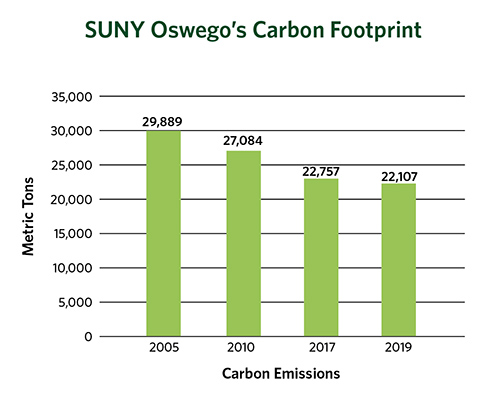
Related content: SUNY Oswego Sustainability Office oversees numerous programs to awareness and change behaviors
More from Featured Content
Vision for the Future
VISION for the Future Peter O. Nwosu began his tenure as the 11th president of SUNY Oswego, building on the solid …
Envisioning the Potential in All Students
ENVISIONING the Potential in All Students Educator donates $2 million in recognition of his Oswego education, in support of future teachers Frank …
A Vision of Support
A VISION of Support Award-winning principal makes an impact on her school through her positivity and commitment When Nicole Knapp Ey ’02 …









